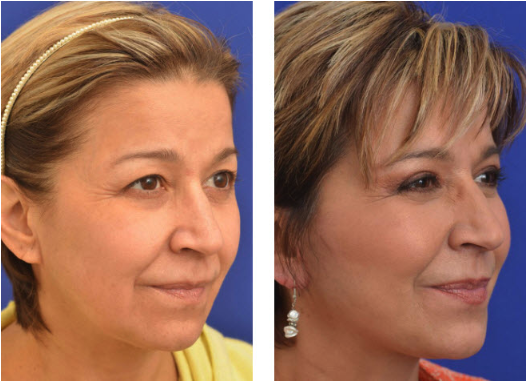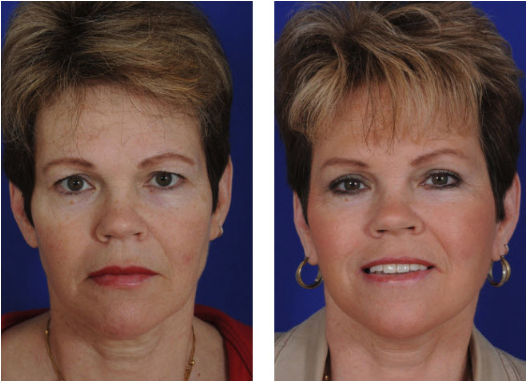Eyelid Surgery
Premier Houston Rhinoplasty Surgeon Dr. Michel Siegel
Our eyes speak the unspoken, whether we want them to or not. They can beam confidence, excitement, or happiness. Or they can look worried, tired, or cold. With eyelid surgery by Dr. Siegel, your eyes can look naturally energetic again. Soon your eyes can reflect what you want to show others and see in the mirror.
To learn more about eyelid surgery, simply read or check out our eyelid surgery FAQs page. You can contact Dr. Siegel’s office here in Houston today to schedule a consultation.
When Might You Want Eyelid Surgery?
Over time, our faces lose volume and facial skin becomes less elastic, causing the brows to descend and our eyes to appear baggy or sleepy due to excess skin. The resulting eyelids may make you appear sad, worried, or angry when you’re not.
We can’t stop time, but in some ways we can slow it down. Houston facial surgery specialist Dr. Michel Siegel performs blepharoplasty (eyelid surgery) that restores the smoothness and natural energy to your eyes, your face, and the image you project to others and to yourself.
Eyelid Surgery Before & After


What Dr. Siegel’s Eyelid Surgery Patients Say
Sam S.
Quinn C.
Cameron S.

What is blepharoplasty, exactly?
Often simply known as eyelid surgery or eyelid lift surgery, blepharoplasty refers to surgery performed on the top eyelids, bottom eyelids, or both to reduce sagging and remove excess skin. A blepharoplasty performed by Dr. Siegel will help you look more awake, rested, and youthful.
Benefits of eyelid surgery
- Less puffiness
- Less bagginess under eyes
- Removal of hooded eyelid skin
- Improved vision from removal of overhanging eyelids
- Lifted eyebrows
- Refreshed appearance
- Smoothed wrinkles around the eyes
- Brighter eyes
How much does blepharoplasty cost?
The cost of blepharoplasty depends on many factors, including:
- The extent of your procedure
- Whether you are having surgery on your upper eyelids, lower eyelids, or both
- Anesthesia and other fees
Dr. Siegel will help you determine the cost of your procedure during your consultation, though you can generally expect a cost of about $3,000 to $4,000.
Is eyelid lift surgery right for you?
Our blepharoplasty can help both functionally and cosmetically. If your vision is affected or obstructed due to drooping eyelids or sagging skin, you may be a good candidate for an eyelid lift. For cosmetic purposes, if you notice sagging brows, bags under your eyes, or puffy and tired-looking eyes, eyelid surgery is probably a good option for you.
What happens in upper eyelid surgery?
Extra tissue on the upper eyelid can make your eyes look droopy, tired, and small. Upper eyelid surgery can remove sagging extra skin, refreshing your overall look. In a blepharoplasty, an incision is created along the natural crease of the eyelid, where a scar will not be visible. Excess skin is removed to make the eye appear more open and alert.
What happens in lower eyelid surgery?
Lower eyelid surgery can also be transformative. If you have fatty deposits and excess skin that can create permanent “bags” under the eyes, lower eyelid surgery can help you look well-rested, refreshed, and more youthful. During the procedure, an incision is placed directly beneath the lower lash line. Then Dr. Siegel removes excess tissue and fat to help you look more alert, taking years off your appearance.
How do I prepare for eyelid lift surgery?
Whether you undergo eyelid surgery for hooded eyelids, bags under your eyes, or loose skin obstructing your view, each eyelid surgery has specific pre- and post-op instructions. Prior to your procedure, Dr. Siegel and our team will go over each of the specific guidelines in detail with you. We will outline everything you need to know about your eyelid procedure, from the week before your surgery through the end of your recovery.
What is eyelid surgery like?
Each eyelid surgery is as unique as the patient, so there’s no one-size-fits-all formula. Your blepharoplasty will be performed under twilight sedation (a light anesthesia), which ensures your complete comfort during the surgery and avoids the side effects and longer recovery time of general anesthesia. Once you are sedated, Dr. Siegel will make a small cut in the natural crease of the upper eyelids to remove excess tissue and skin, reposition or remove fat deposits, and tighten muscles as necessary.
On the lower lids, the incision will be made just below the lower lash line or inside the eyelid. Once the surgery is completed, the incisions will be closed with tiny sutures. Gauze and ointment may be placed over your eyelids as well.
Dr. Siegel’s expertise in the most advanced techniques in facial plastic surgery allows him to perform the eyelid surgery precisely. The result is that you achieve natural and balanced results for a refreshed, not overdone, appearance.
What can I expect in recovery from eyelid surgery?
Because Dr. Siegel focuses exclusively in the field of facial plastic surgery, he has a greater depth of experience and expertise than do most other surgeons performing blepharoplasty. That allows him to complete even the most complex procedures with minimal swelling and discomfort. Our patients often find recovery from blepharoplasty much easier than what they’ve heard from others or read about online. Most patients are able to return to work as quickly as 5 days, with minimal signs of surgery.
The day of surgery
On the day of your blepharoplasty, you should plan on resting afterwards. Many patients return to work after three to five days with no noticeable signs of surgery. For the first week or two following the procedure, wear sunglasses and avoid straining your eyes. You will also want to avoid strenuous activity for at least two weeks after surgery.
Check out our page on eyelid surgery aftercare instructions.

Why choose Dr. Michel Siegel for your otoplasty?
The success of your facial surgery depends above all on the surgeon you pick. Dr. Siegel is a super-specialized facial surgery specialist. He is double board certified by the only two boards certifying facial specialists (abohns.org and abfprs.org. Those certifications and his 20+ years of exclusive facial surgery experience, allow him to deliver results that exceed expectations..
Facial Plastic Surgery is more than just a surgical procedure. You need a surgeon that is not only technically superb, but also a human being that you are able to connect with, able to listen to “your” needs, and is empathetic. All those qualities are reflected on Dr. Siegel’s approach to your care-from your first consultation to your last follow up.
Find out even more about why to choose Dr. Siegel, or contact us to discuss your individual goals.
Frequently Asked Questions About Eyelid Surgery
Question:
Will I have visible scars after blepharoplasty?
Answer:
Dr. Siegel is careful to place incisions in hidden locations, so they are invisible once healed. Upper eyelid blepharoplasty involves a scar in the natural fold of your upper eyelid that heals to a thin line and is hardly noticeable, even with closed eyes. Lower eyelid blepharoplasty involves an incision near the lower lash line or within the lower eyelid. An incision inside the eyelid will not show, but even an outward incision will heal nicely with our meticulous surgical techniques.
Question:
How can I prevent scarring after eyelid surgery?
Answer:
Proper care during the healing stages will help you avoid any complications. Follow all aftercare instructions from Dr. Siegel and give yourself time to heal adequately before returning to work, exercise, and the rest of your routine. Our knowledgeable surgeon uses the latest technology to reduce scarring and create impressive results. Taking good care of yourself after surgery is one of the best ways to ensure your recovery is smooth and swift.
Question:
Is eyelid surgery covered by insurance?
Answer:
Insurance companies typically will not cover cosmetic procedures, like eyelid surgery. Even so, eyelid surgery may be covered by your health insurance if the excess drooping eyelid skin is affecting your vision. Our friendly administrative staff will be happy to help you with any questions regarding insurance or financing.

